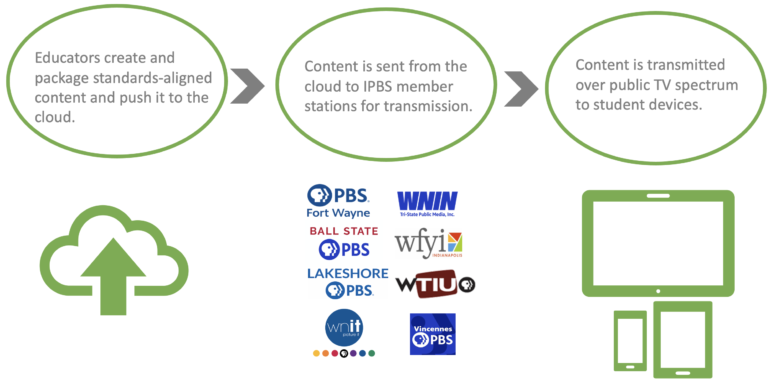What is datacasting? Datacasting is a term derived from ‘data’ and ‘broadcasting’.
Datacasting essentially mimics the internet experience, but instead of using broadband or WiFi, it uses TV broadcast spectrum to carry data to computers. Datacasting converts a portion of the television broadcast signal to a one-way transmission of encrypted IP data.
Datacasting has been used for decades to support public safety and public emergency incidents. Using it for education is new.
IPBS and its member stations, through grants awarded by the State of Indiana, have deployed datacasting to bridge the digital divide for students learning from home. Using datacasting to provide instructional content to students with little or no internet access is a significant development.
How it works:

What is the End-User Experience?
In order to receive files via datacasting, a student needs a Wi-Fi enabled device (i.e., cell phone, computer, tablet, etc.), as well as an inexpensive antenna and receiver. No internet access is required.
Any type of file (jpg, PDF, mp4, etc.) can be transmitted via datacasting. This means that the possibilities of creating and packaging content designed for instruction are limitless. Our goal is to create a personalized learning experience for students who would not otherwise have access to online resources.
Datacasting is currently one-way. Research and design are underway to develop an integrated return path that facilitates two-way interaction, allowing students to send completed work/assignments directly back to their teacher.
School districts will datacast a variety of instructional items, including recorded lectures, live lectures, problem sets, reading units, lesson plans, quizzes, tests, and a host of classroom assignments. Many of the items will be self-created by teachers, while the balance will be acquired from other sources such as PBS Learning Media.
Datacasting Video
FAQ
Is datacasting expensive?
The cost to stand-up and maintain datacasting is relatively modest. It is cheaper than installing hotspots to deliver an internet signal. Households require a receiver and antenna to pick-up the signal and television stations must have a datacasting gateway to distribute it.
When will datacasting be available for educational use?
Datacasting for education is available right now and is being used by schools in Indiana.
How can my Local Educational Agency become involved in datacasting?
Interested Local Educational Agencies within Indiana should reach out to IPBS at info@IPBS.org. If your organization is located outside of Indiana, then contact our datacasting solutions provider, SpectraRep.
Where can I find additional information on educational datacasting?
You can direct additional questions regarding datacasting to info@IPBS.org.
Setting Up Your Datacasting Equipment
Read the instructions below for how to set up your in-home datacasting antenna and receiver.
Install directions for datacasting students
Instrucciones para instalar el equipo de difusion de datos para los estudiantes
Watch this video for instructions on how to set up your in-home datacasting antenna and receiver.
Special thanks to SCETV for their overview information on datacasting.